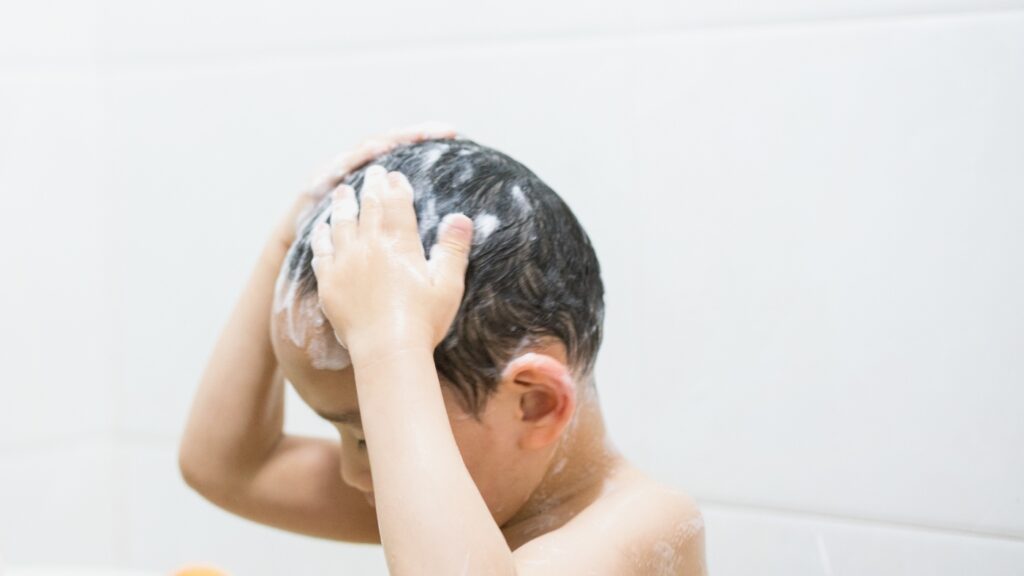Current use of hair and skincare merchandise have been linked to increased ranges of endocrine-disrupting chemical compounds in youngsters.
Allen Chen/Getty Photos
cover caption
toggle caption
Allen Chen/Getty Photos
A new research hyperlinks the latest use of non-public care merchandise like lotions, ointments and hair conditioners to increased ranges of endocrine-disrupting chemical compounds referred to as phthalates in younger kids. And kids of various racial and ethnic teams appeared to have completely different ranges of publicity to those chemical compounds.
Phthalates are a bunch of chemical compounds added to plastics to make them extra versatile and sturdy. They’re additionally used as substances in some private care merchandise.
These chemical compounds are endocrine disruptors – which suggests they will mimic, block or intrude with the physique’s personal hormones. And in the case of kids, the priority is that they may trigger disruptions throughout key developmental moments.
Prior research have linked common publicity to phthalates throughout being pregnant and early childhood to unfavorable impacts on kids – together with impaired mind growth and behavioral issues, in addition to different well being considerations.
Researchers have additionally raised considerations that the widespread presence of endocrine-disrupting chemical compounds like phthalates within the surroundings could also be contributing to ladies getting their first menstrual interval at an earlier age.
Phthalates don’t keep within the physique for very lengthy, however well being researchers fear concerning the cumulative results of these exposures.
The scientific proof on the harms of phthalates just isn’t but conclusive, however it accumulating and compelling, says Michael Bloom, a professor at George Mason College whose analysis focuses on endocrine-disrupting chemical compounds. “And that is why we have now nice concern, particularly amongst these very younger kids whose brains are nonetheless very actively growing,” Bloom says.
In the brand new research, printed within the journal Environmental Well being Views, Bloom and his colleagues examined scientific knowledge from 630 kids ages 4 to eight from whom they’d collected urine samples. Their mother and father or guardians stuffed out surveys about any hair and skincare merchandise they’d utilized to the kid throughout the previous 24 hours.
“We discovered that the latest use of a number of various kinds of skincare merchandise was related to increased urinary concentrations of a number of various kinds of phthalates,” Bloom says. That, in itself, isn’t new: He notes that prior research have discovered related ends in infants and pregnant ladies, although not in younger youngsters on this 4-8 age vary.
However the brand new research gives clear proof of the hyperlinks between youngsters’ exposures and a variety of non-public care merchandise, says Dr. Lynn Goldman, a pediatrician and epidemiologist who previously served as an assistant administrator for poisonous substances on the Environmental Safety Company. She was not concerned within the new research.
Goldman notes that till now, considerations about phthalate publicity have typically centered on weight loss program, for the reason that chemical compounds can leach into meals from plastic packaging, in addition to meals dealing with tools reminiscent of tubing and conveyor belts.
“I feel we must be far more involved than we have now been previously about the truth that these [chemicals] could be allowed in cosmetics and private care merchandise,” says Goldman, who’s now the dean of the Milken Institute Faculty of Public Well being at George Washington College.
Bloom and his colleagues additionally discovered variations in phthalate exposures by race and ethnicity. For instance, they discovered robust associations between the usage of hair oils and elevated phthalate ranges amongst kids who recognized as Hispanic, Asian and Pacific Islander. In the meantime, the usage of physique lotion was related to the sorts of phthalates used as substances in private care merchandise amongst white kids however not amongst Black and Hispanic kids. Bloom speculates that a few of these variations might stem from variations within the sorts of merchandise marketed to completely different teams, “however we’ve not been capable of disentangle that.”
General, Black kids had the very best ranges of phthalates of their urine. Different research have discovered that many magnificence merchandise focused at communities of shade have excessive ranges of those chemical compounds.
“I feel this can be a essential research, as a result of we have to perceive exposures in susceptible populations reminiscent of kids,” and understanding variations in exposures by racial and ethnic backgrounds may help researchers determine methods to scale back dangers, says Dr. Shruthi Mahalingaiah, an assistant professor of environmental, reproductive and ladies’s well being at Harvard T.H. Chan Faculty of Public Well being who was not concerned within the present research.
And as social media helps gasoline a craze for skincare amongst tweens and teenagers, Mahalingaiah says the findings are an vital reminder that a few of these merchandise may doubtlessly be exposing youngsters to endocrine-disrupting chemical compounds.
“I’ve three teenage kids who’re very fascinated about merchandise and self-care merchandise. And it is one thing that I am very involved about,” she says.
She had her teenagers obtain a free app referred to as YUKA. Consumers can merely scan the barcode of a product whereas within the retailer, and the app will flag potential well being considerations linked to substances. She notes you too can lookup merchandise within the Environmental Working Group’s Pores and skin Deep database.
In the end although, Goldman says, “I do not assume that it is actually as much as mother and father to be policing the substances in these merchandise. I feel it is a job for the FDA. It is a job for the EPA.”
She says extra analysis is required, however the findings reinforce the necessity for regulators to take a more in-depth take a look at this household of chemical compounds and ask more durable questions on how all this cumulative publicity could also be affecting kids and different susceptible populations.
This story was edited by Jane Greenhalgh


